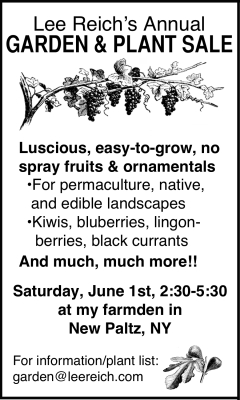A New, Old Twist on Strawberries
/9 Comments/in Fruit/by Lee ReichStrawberries White and Early
Awhile ago I plucked some ripe strawberries and handed them to Rachel for a taste. Her ho-hum reaction told me that I hadn’t picked carefully enough. Yes, the berries were white, but that’s their color when ripe — and also when not ripe.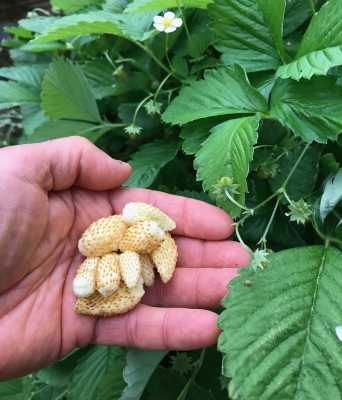 You should be scratching your head by now. Strawberries that are white when ripe? Strawberries perhaps ready for harvest in early May here in the Hudson Valley?
You should be scratching your head by now. Strawberries that are white when ripe? Strawberries perhaps ready for harvest in early May here in the Hudson Valley?
The berries I handed Rachel were alpine strawberries (Fragaria vesca), a different species from our usual garden strawberries (F. X ananassa). They are a kind of “wood strawberry” (often going under their more upscale-sounding French moniker fraises de bois) first encountered about 300 years ago near Grenoble, France. These strawberries are different from garden strawberries in many ways.
For one thing, alpine strawberries are everbearing. They’ll pump out fresh berries as long as given sufficient warmth, water, and nutrients. Mine are bearing now because they’re planted in the ground in my greenhouse. In my pre-greenhouse life they fruited for me in early spring in 3” diameter pots in a sunny window.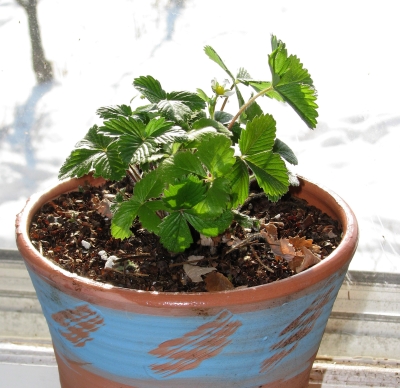 And no, the plants hadn’t resided in my home and aren’t now in my greenhouse to protect them from winter cold. I wanted an earlier crop. I also grow them outdoors.
And no, the plants hadn’t resided in my home and aren’t now in my greenhouse to protect them from winter cold. I wanted an earlier crop. I also grow them outdoors.

‘Pineapple Crush’ strawberries
Alpine strawberry plants are adapted from where winter temperatures plummet below minus 30°F. to regions that hardly experience winter.
These strawberries also part ways with garden strawberries in not producing any runners. I consider this a plus because the worst weeds in a garden strawberry bed are often the plants themselves. As runners strew about and take root, they crowd each other out. The resulting shade and higher humidity make for lower yields and plants more prone to disease.
About 40 years ago, alpine strawberries were hybridized with garden strawberries, with the resulting plants showing typical hybrid vigor with larger fruits and more robust growth. The variety Florika was one of those hybrids, billed as having very good flavor and sufficient vigor and disease resistance so that it can be planted to create a fruiting meadow. Sara and Rebecka are two other hybrids. (Unfortunately, all are red-fruited.)
I’ve never grown any of these hybrids, but will — very soon. Stay tuned.
Small, But Very Easy to Grow
Alpine strawberries are not the strawberries to grow to fill your freezer for winter. Unless you have a lot of patience, that is, because the berries are small, typically about the size of a dime. (The hybrids bear larger fruits, measuring over an inch long.)
You also will rarely, if ever, find the ripe fruits for sale. If they are truly ripe, they are very, very soft, and very, very perishable. The only way to truly experience these berries them is to grow them yourself (easy) and then harvest them dead ripe (pretty easy).
The plants thrive in moderately rich, well-drained soil in full sun or partial shade. In pots, any basic potting mixture will suffice.  A planting can be started from plants or seeds, the latter started just as are tomatoes. Plants grown from seeds planted in spring will begin bearing their first season.
A planting can be started from plants or seeds, the latter started just as are tomatoes. Plants grown from seeds planted in spring will begin bearing their first season.
New plants can also be made by dividing old plants, cutting the crown into pieces along with their attached roots. As with many herbaceous perennials, division or starting new plants is a necessity as plants age and their centers become woody and decrepit.
As far as timely harvest, one way is to follow your nose; the berries are extremely fragrant when ripe. Look at the berries: Ripe ones turn from white to creamy yellow, and their seeds darken to brown. Just the gentlest coaxing removes a ripe fruit from its stem.
Scrumptious!!
A number of gardeners grow alpine strawberries, the red-fruited kinds, which come in a number of varieties. There are, likewise, many varieties of white-fruited alpine strawberries. One year I decided to see just how different these varieties are from one another.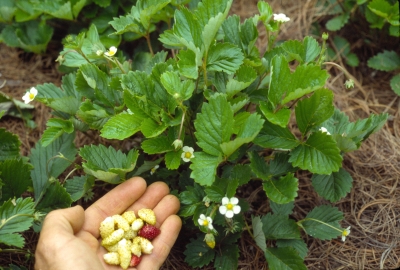 It turned out that all the red-fruited ones were similar, as were the white-fruited ones. For me, the white ones definitely had better flavor. And the flavor could be enjoyed. Why? Because until they are dead ripe, alpine strawberries have taste somewhat akin to cotton soaked in lemon juice. Problem is that birds are very attracted to, and eat, the red fruits no care as to whether or not the berries are dead ripe.
It turned out that all the red-fruited ones were similar, as were the white-fruited ones. For me, the white ones definitely had better flavor. And the flavor could be enjoyed. Why? Because until they are dead ripe, alpine strawberries have taste somewhat akin to cotton soaked in lemon juice. Problem is that birds are very attracted to, and eat, the red fruits no care as to whether or not the berries are dead ripe.
Birds don’t notice the white fruits when they are ripe so leave them alone for our enjoyment.
A few days ago, when I again saw Rachel, I offered her some more carefully picked fruit. She put them in her mouth, blinked and then open her eyes wide, and exclaimed, “Wow!” That’s the usual reaction to the fruit. Ripe, the white fruits are sweet and richly aromatic with a commingling of scrumptious flavors of strawberry and pineapple.
———————————————
Any gardening questions? Email them to me at garden@leereich.com and I’ll try answering them directly or in this column. Come visit my garden at www.leereich.com/blog.
Grape Futures
/6 Comments/in Fruit, Pruning/by Lee ReichMy Rationale for Pruning so Late
Today I put the finishing touches on pruning my grapevines. Yes, it’s late: The buds have already swollen and expanded into clusters of small leaves. But there’s “method in my madness,” or, at least, my tardiness.
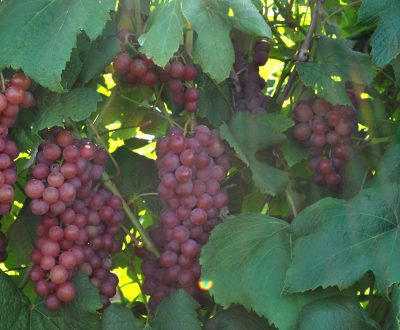
Vanessa grapes
My vines often experience some winter damage, some varieties — New York Muscat, Reliance, and Vanessa, for instance — more than others. Waiting to prune until I see some green saves me from cutting off too many living canes and saving too many dead canes. In winter it’s not so easy to tell them apart.
So I do mostly rough pruning in winter, lopping back canes that have to go whether they’re living or dead. Canes also need to be shortened, even those that are to be eventually saved.
Which brings me to another reason I left the final pruning until today. Plants generally make their earliest growth in the season starting at the tips of shoots or canes. So when I shortened the remaining canes in winter, I didn’t cut them all the way back to their final length. Then if a late frost nips or kills early growth, it’s no problem. The canes are going to be shortened even further — today — to where buds were not as fully awake and susceptible to cold.
But waiting too, too long to prune can be problematic because those swollen buds flick off their resident canes with very little coaxing. Leave too much to prune this time of year and a lot of buds fly off as pruned canes are pulled down off the plant.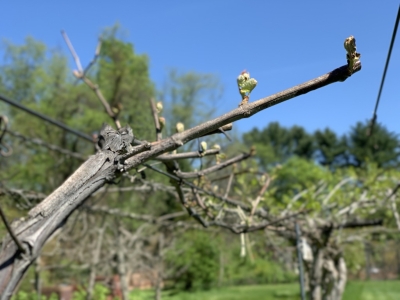
Why Prune? How?
A grapevine bears fruit near the bases of shoots that grow off one-year-old canes. Left to its own devices, the vine might grow 50 feet up into a tree, bear so heavily that it can’t provide sufficient energy to pump optimum flavor into each berry, and become a dark, dank, tangled mess of stems — perfect conditions for fungal diseases.
The goal of various methods of training and pruning grapes are the same: to leave a suitable number of canes conveniently positioned for harvest; to provide buds to grow into new, well-placed shoots for fruiting the following season; and to create a form that allows for good light and air circulation. As might be expected of a plant that’s been cultivated for thousands of years, many ways have been devised for training grapes.
The Four-arm Kniffin System is a kind of “cane pruning,” a traditional method of training in eastern U.S.. For support, a two-wire trellis, with one wire 6 feet and the other wire 3 feet above ground, is needed. The mature plant consists of a trunk with four canes growing from it, two trained in opposite directions along the upper wire and two similarly trained along the lower wire.
Pruning begins as four canes to carry the season’s fruits are selected. These canes should be moderately vigorous and originate close to the trunk and near the wires. With this year’s fruiting canes selected, plans for the following season’s crop are made by cutting back some stems to two buds each; these renewal spurs, as they are called, provide points of origin for new shoots (which will become fruiting canes in a year) near the two wires and on either side of the trunk.
Next, lop away all growth except for the four renewal spurs and the four saved canes. Finally, shorten each of the canes to about 6 ft. in length, leaving about 10 buds per cane (not counting bud clusters near the bases of the canes). This leaves ten times four, or 40, fruiting buds on the plant.
Many Methods with the Same Goal
At the other extreme in pruning is “spur pruning,” where all that’s left is many 2-bud canes (now called “spurs”) from which grow fruiting shoots. “Head training” would be the most basic spur pruning, with the pruned vine left with nothing more than a trunk capped by a number of spurs.
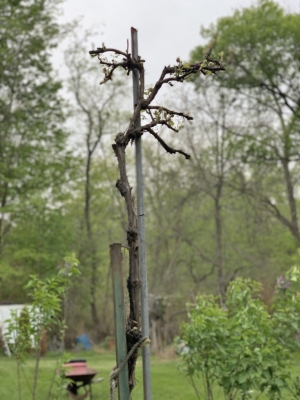 A spur-pruned vine might instead sport a permanent trunk topped by two arms — permanent arms, called “cordons,” in this case — that run in opposite directions along a trellis wire.
A spur-pruned vine might instead sport a permanent trunk topped by two arms — permanent arms, called “cordons,” in this case — that run in opposite directions along a trellis wire.
Instead of leaving 4 long canes on which to bear fruit, many short, 2-bud canes are left along the cordons. To get the same number, 40, of fruiting shoots on a spur-pruned vine as on a Kniffen-pruned vine, twenty 2-bud spurs are left. All excess are cut away so that those that remain are 6 to 12 inches from their neighbors.  Over time, some spurs will stretch, even after being shorted to 2 buds of one-year-old shoots, further away from the cordon. Lopping these back nearer the cordon puts them back in order.
Over time, some spurs will stretch, even after being shorted to 2 buds of one-year-old shoots, further away from the cordon. Lopping these back nearer the cordon puts them back in order.
Where to put all those fruiting shoots growing from the spurs? With “midwire” cordon training, cordons are trained along a wire at 3 foot height, and new shoots are trained upward by weaving them into 3 rows of wires strung at one foot above the cordon wire. 
With “high-cordon” training, a trunk rising to about 6 feet is capped by two cordons trained in opposite directions along a wire. Fruiting shoots droop downward.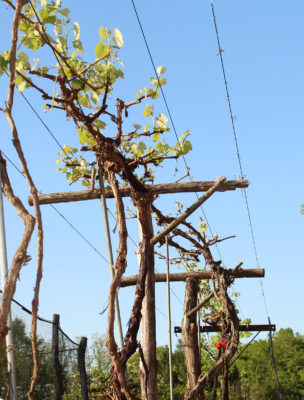
My grapes grow as high cordons, with a wrinkle; their fruiting shoots spread horizontally, rather than droop down. Wooden cross pieces provide this support on my arbor. Although this rigorous pruning puts off how soon the arbor offers relief from early summer sun, the arbor never becomes a tangled mess of stems and disease-ridden berries characteristic of many helter-skelter pruned grape arbors.
The trellis for my other high-cordons have two sets of wires running parallel on either side and one and three feet from the cordon’s wire. These wires provide a ledge on which fruiting shoots can rest, with clusters of grapes dangling just high enough for me to reach for easy harvest.

